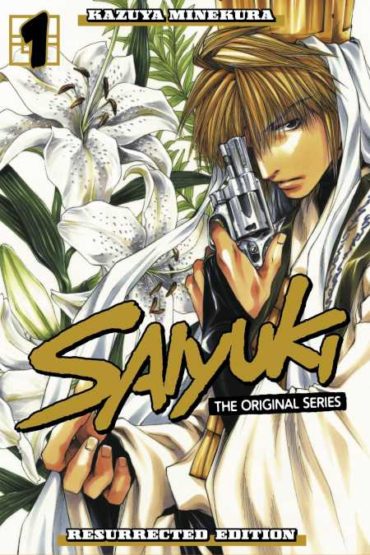Saiyuki The Original Series Resurrected Edition Volume 1
‘In the Age of Chaos, when Heaven and Earth were intertwined, humans and yokai lived together in the fount of culture and faith, Togenkyo.
‘But suddenly, a wave of negative energy spread across this world, causing the yokai to lose their minds and become violent.’
Genjyo Sanzo is a young Buddhist priest who is sent by the divine Kanzeon Bosatsu from the once-peaceful land of Togenkyo to the West. His mission? To discover why the yokai have turned against the humans and are slaughtering them at every available opportunity – and to stop them. He’s accompanied by three yokai with human souls: Son Goku, the youthful and ageless Monkey King; Sha Gojyo, the kappa/water spirit, who regards himself as a ladies’ man and Cho Hakkai, whose little white dragon companion, Hakuryu, conveniently shapeshifts into a jeep to carry the four on their travels. It turns out that the disturbance among the yokai has been precipitated by an ongoing experiment, a forbidden mixture of magic and science, to revive the bull-demon king Gyumaoh (who hated humans). His son, Goukaiji, accompanied by his own faithful retainers and his half-sister Lirin, is sent out to stop Sanzo’s party.
Saiyuki unfolds as a road trip, following Sanzo and his companions through a world that’s not quite our own: gods and yokai mingle with humans; cigarettes, credit cards, guns and jeeps exist alongside traditional ways of life. The gang are frequently attacked or entrapped, encountering corrupt priests and a seductive spider woman as well as innumerable yokai determined to stop them.
Journey to the West, the 16th century Chinese novel about a Sanzo priest’s adventures on a pilgrimage to the West to collect divine sutras with three unusual companion/protectors has inspired numerous manga, anime and live films – and Saiyuki by Kazuya Minekura is probably the best-known (after Akira Toriyama’s Dragon Ball). Minekura’s ‘pilgrims’ are bishonen, possibly the most good-looking reinventions of the four central characters so far. This series made its debut back in the last century (1997) and it’s been running on and off ever since (sadly, the mangaka has had significant health issues but she’s always returned to it when she can) with several successful anime series released. The secret of its success is undoubtedly down to her distinctive character art, her recreation of the legendary heroes as bad boys with attitude who smoke and drink (except for Son Goku, who’s always hungry). Bad boys with attitude (and guns) were very popular back then (think Spike in Cowboy Bebop or Vash the Stampede in Trigun) and even though it feels a little dated, there’s no denying the raw energy and compelling storytelling it delivers. The glimpses it affords of tragic backstories for each of the protagonists draw the reader in, eager to learn more about what lies beneath their self-confident, worldly-wise swaggering; bad boys, traditionally, have had to develop tough exteriors to conceal their raw inner wounds.
Goukaiji, the rebellious son of Gyumaoh, becomes a significant character as the story progresses, as do his companions. He has his own complex reasons for hating his father – but he and his three followers are often portrayed by the mangaka as sympathetic but formidable opponents, especially the faithful Yaone, a beautiful but deadly apothecary/assassin.
So, how well has this picaresque road trip of a manga stood the test of time? It’s still an engaging (although frequently violent) read. Sanzo’s readiness to pull his gun (on friends as well as enemies) grates after a while – and the constant cigarette-smoking (associated in manga back in the day with being really grown-up and sophisticated) would be frowned upon now. But there’s an irresistible charm that shines through the cigarette smoke and the deep sense of camaraderie between the bickering heroes that appears whenever they run into danger is convincing and genuinely touching.
The excellent translation from the original Tokyopop edition (2002) by Alethea Nibley and Athena Nibley captures just the right tone of voice for the members of the Sanzo party, constantly arguing and joshing each other. Character profiles round off the first volume and a short comic bonus (soon to become a regular feature) concludes the second. The illustrated translation notes (collected at the back) are full of fascinating details about the mythology and Buddhist background to the story; there are also ten vibrant glossy colour pages showcasing Minekura’s art to great effect. And if the art is a little inconsistent in the early chapters, the mangaka soon gets into her stride, delivering the striking character portrayals that makes her work stand out.

This is a very welcome reprint in a handsome 2-in-1 hardback (as well as digital) of the first series of a landmark manga that existing fans will doubtless be keen to add to their collections and may well attract a new generation of fans to Kazuya Minekura’s work. The second volume (containing #3 and #4) is due out mid-May (in digital format, hardback to follow.)
Read the first chapter of Saiyuki for free at the publisher’s website here.


